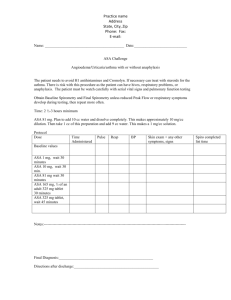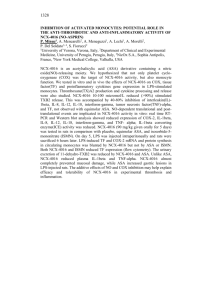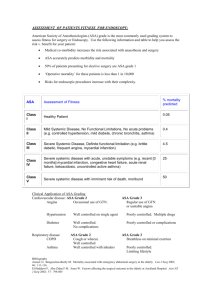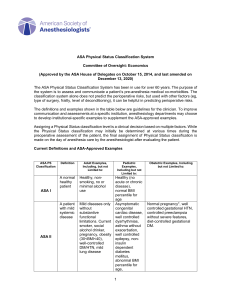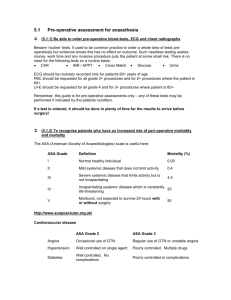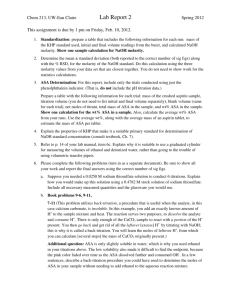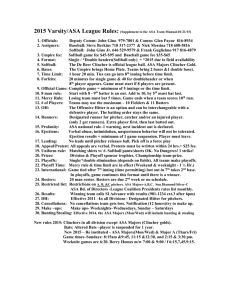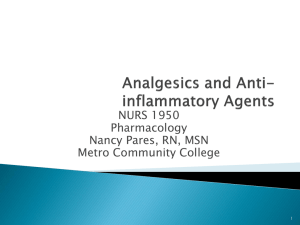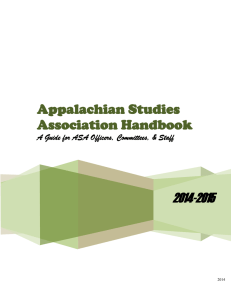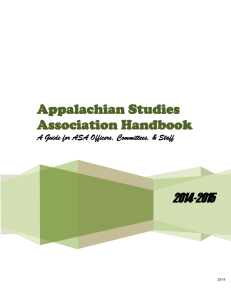Case 10-Anesthesia for healthy patient
advertisement
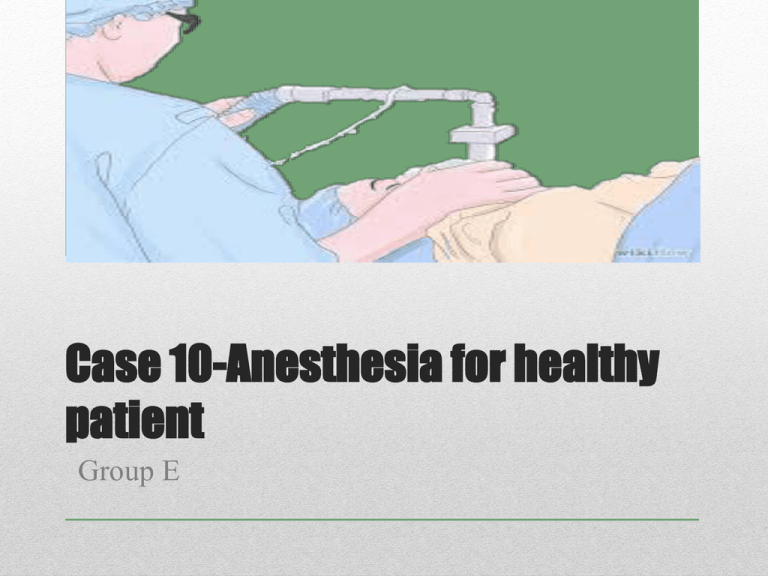
Case 10-Anesthesia for healthy patient Group E • A 52-year-old man has had progressive knee pain with swelling, His orthopedic surgeon has tentatively diagnosed a torn meniscus, and recommended an arthroscopy as an outpatient. The patient has had no major illnesses other than the typical childhood diseases. He has had no previous operations or anesthetics, nor a family history of problems with anesthesia. He has no allergies to medications, does not smoke, and consumes alcohol occasionally at social events. His laboratory results and physical examination by an internist were all normal. He has had nothing to eat or drink since he went to bed last night. On examination, the patient weighs 75 Kg and is 182 Cm, in tall. His neck appears to be flexible and mobile. He opens his mouth without difficulty, and with his head extended and tongue protruding, his uvula is completely visible. 1. How are a patient’s general medical condition, and his risk for difficult airway management classified? • A patient's ASA Physical Status Classification, noted as ASA I-IV, categorizes patients according to their comorbidities. He is on stage 2 of ASA Classification. Classific ation ASA I A normal healthy patient. Healthy, non-smoking, no or minimal alcohol use. ASA II A patient with mild systemic disease. Mild diseases only without substantive functional limitations. Examples include (but not limited to): current smoker, social alcohol drinker, pregnan obesity (30 < BM < 40), well-controlled DM/HTN, mild lung disease. ASA III A patient with severe systemic disease. Substantive functional limitations; One or more moderate to severe diseases Examples include (but not limited to): poorly controlled DM or HTN, COP morbid obesity (BMI ≥40), active hepatitis, alcohol dependence or abuse, implanted pacemaker, moderate reduction of ejection fraction, ESRD undergoing regularly scheduled dialysis, premature infant PCA < 60 weeks, history (>3 months) of MI, CVA, TIA, or CAD/stents. ASA IV A patient with severe systemic disease that is Examples include (but not limited to): recent ( < 3 months) MI, CVA, TIA, a constant threat to life. CAD/stents, ongoing cardiac ischemia or severe valve dysfunction, severe reduction of ejection fraction, sepsis, DIC, ARD or ESRD not undergoing regularly scheduled dialysis. ASA V A moribund patient who is not expected to survive without the operation. ASA VI A declared brain-dead patient whose organs are being removed for donor purposes. Examples include (but not limited to): ruptured abdominal/thoracic aneurys massive trauma, intracranial bleed with mass effect, ischemic bowel in the face of significant cardiac pathology or multiple organ/system dysfunction. The Mallampati airway classification is used to predict the ease of intubation . It describes the amount of a patient’s uvula visible when a patient extends his neck and protrudes his tongue and is one predictor of the risk of difficult airway management. 2. In which stage of anesthesia is the patient most vulnerable, and why? The 4 stages of Anasthesia: • Stage 1: Stage Of Analgesia (From beginning of induction of general anesthesia to loss of consciousness). Patient doesn't feel pain anymore, he is drowzy, no change in HR or BP. • Stage 2: Stage of Excitement (From loss of consciousness to onset of automatic breathing). Patient is excited, delirious,Respiration becomes irregular, rate increases, Jerky movements of different body parts. Due to these jerky movements, patient may injure himself, vagal stimulation leading to cardiac arrest or cardiac arrhythmias due to excess of catecholamines or inhibition of inhibitory centers. • Stage 3: Stage of Surgical Anesthesia (From onset of automatic respiration to respiratory paralysis). In this stage patient is asleep, pulse is steady and slow, blood pressure and respiration are normal. This is the phase where surgery is usually performed. The surgeon wants to keep the patient in this stage of anesthesia. • Stage 4: Stage of Medullary Paralysis (From stoppage of respiration till death). During this stage of medullary paralysis, cardiovascular and respiratory centers in medulla are so much suppressed by anesthetics that it could lead to cardiovascular collapse or respiratory failure. which may end in come or even death. Patient should not go into this stage. • Patients are most vulnerable in stage 2 because they lose both their airway reflexes and autonomic stability and become hyperexcitable to external stimuli. 3. Which components of a preanesthetic evaluation are often not included in a patient’s typical history and physical examination? • The guidelines of the American Society of Anesthesiologists (ASA) indicate that a preanesthesia visit should definitely include the following: • An interview with the patient or guardian to review medical, anesthesia, and medication history. • An appropriate physical examination. • Review of diagnostic data (laboratory, electrocardiogram, radiographs, consultations, blood hemoglobin, blood loss estimation, and blood availability). • Assignment of ASA physical status score (ASA-PS).
